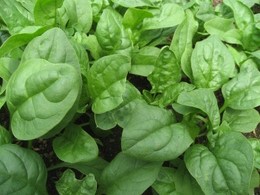Spinach Growing Guide
Spinach (Spinacia oleracea) is a cool season annual vegetable that can be planted in the early spring and late summer. It is a tasty and nutritious vegetable that is one of the first things that you can plant in the spring.
Soil Preparation
The soil should be nice loose well drained organic garden soil with the soil pH between 6.5 and 7.5. As soon as the soil is frost-free and can be worked, till the soil by digging down 8 to 12-inches turning the soil over with a garden fork.
Remove any large rocks and stones. The small stones remaining will do no harm and actually benefit the soil by adding some micro-nutrients to the soil.
Planting Spinach
Plant spinach in an area that gets full sun to light shade. Spinach is shallow rooted and will do best if direct sown in the garden. For spring planting sow the spinach seeds in the early spring when the soil reaches 35 to 40-degrees.
Plant your spinach seeds in rows 6-inches apart. Make a shallow furrow ½-inch deep. Space the seeds 1-inch apart along the row. Mark the rows with a plant tag and then cover the spinach seeds back over with the soil you pushed aside.
Lightly pat the soil down and gently water, checking back each day to keep the soil from drying out. When the spinach seedlings are 2 to 3-inches tall, thin them to 5 to 6-inches apart. Keep the soil moist to help keep them from bolting. At the first sign of bolting it is time to start planting another crop of spinach using a variety that will do best in warmer weather.
For summer and fall planting the seeds will suffer from spotty germination if the soil is too warm. To cool off the soil place a thick layer of mulch 1 to 2-weeks before planting. After planting the seeds, provide some light shade by using row cover or window screening to keep the soil from getting too hot. Remove after the seeds germinate.
For more detailed information visit the seed starting page.
Watering and Care
After the seeds germinate start adding a layer of mulch of shredded leaves or pine straw to help retain moisture and keep out competing weeds. During dry spells give some water each week. They are a cool weather crop that likes cool moist soil.
Harvesting Spinach
Pick the outer leaves near the base when they are about 3-inches long. As your spinach continues to grow and if the plants seem to be getting too crowded do some more thinning. The leaves will keep in the refrigerator for a week and are often eaten raw in salads as well as cooked as a side dish with meals. It is high in calcium, iron and is a good source of vitamins A, B and C.
Diseases and Pests
Cucumber mosaic virus, downy mildew and some other fungal leaf diseases occasionally are a problem. Rotating your crops and providing enough air circulation helps avoid most problems. Also look for disease resistant varieties.
Leaf miners can be controlled by using floating row covers.
Popular Varieties
Spring: America, Avon Hybrid, Dark Green Bloomsdale, Indian Summer, Melody, Space, Tyree
Summer: Crocodile Hybrid, New Zealand Spinach, Malabar Spinach
Fall: Avon Hybrid, Melody, Tyree, Winter Bloomsdale
Sources: Seeds Now, Burpee, Johnny’s Selected Seeds
Tips and Warnings
Spinach tends to start bolting and going to seed when the temperature gets too hot and when they get 14 to 16 hours of sunlight. Plant the varieties that do best during the summer.
To keep a continuous supply coming sow more seeds every 7 to 10-days.
Mulch and water when needed.
Garden Spikes newsletters give you timely information once or twice a month. Subscribe Free to the Garden Times newsletter below.
Your email address will only be used to send you a newsletter and will never be sold. You can unsubscribe at any time.

